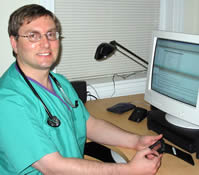 |
|
|
|
Below is an abstract delineating my research on PDA use by Virginia PAs (Physician Assistants). This research arose in order to complete Masters of Physician Assistant requirements mandating a research project on any area relevant to the PA profession. My first research idea was to study the psychosocial health effects of high school athletic participation, but since gaining high school permission is almost impossible, I thought: "Why not research something I tinker with every day…my Palm PDA?" My physician assistant class began in 2000, just
as PDAs were emerging in public and medicine. It wasn't long after
school started that one student after another, like popcorn popping,
started purchasing PDAs (primarily Handspring Visor). Without
definitive school support, all PDA purchases were non-subsidized.
Most of my classmates characterize their PDAs as "indispensable."
Conversely, PDA use by EVMS PA faculty is minimal. Furthermore,
PDA use by EVMS PA students is strongly discouraged in PA faculty
taught classes. Apparently, the thinking is that PDAs "interfere"
with learning. I own a Palm m505, with additional 64 MB SD memory, and I use it primarily for date book/address book, and for medical/pharmacological reference. It is definitely much easier to carry my Palm, than the equivalent hard copy! I firmly believe in the systems-theory idea that energy flows toward greater organization. Since PAs perform physician-type tasks, PA PDA use advantages are the same as for MDs. In my experience, it is not uncommon for PDA-using PAs to inspire PDA use by their physician colleagues. Personal Digital Assistant/Handheld Computer Usage Patterns of Virginia Physician Assistants Background: PDAs (Personal Digital Assistants)/handheld computers have recently entered the medical arena, and are poised to radically alter the way medicine is practiced. Studies of PDA usage by PAs (Physician Assistant)s are extremely sparse, but extremely important. Objective: To determine PDA use and usage patterns by Commonwealth of Virginia PAs. Methods: A survey eliciting PDA use and usage patterns was developed and mailed to all 349 Virginia Academy of Physician Assistants members, representing 43 % of the 808 licensed Virginia PAs. Completed survey results were tabulated using SPSS software, and subsequently analyzed. Results: 200 of 349 surveys (57.3 %) were completed, representing 24.7 % of all licensed Virginia PAs. About half (48.5 %) of surveyed Virginia PAs currently own a PDA, with 19.6 % of non-owners intending to purchase a PDA in the next 12 months. Reasons for non-purchase are primarily "cost" (22 %) and "lack of familiarity" (17 %). Most PDA owners have Palm OS (operating system) PDAs (96 %), with most of the PDAs being Palm (51 %) or Handspring (41.8 %) brand. 59 % of PAs less than 37 years old own PDAs, compared to 37 % of PAs greater/equal to 37 years old. 50.7 % of males surveyed own PDAs, compared to 45.9 % of females. 76.8 % of surveyed PA students own PDAs, compared to 38.8 % of working PAs. While 43.4 % of respondents considered themselves to be "early adopters" of technology in general, almost as many non-adopters (42.3 %) as adopters (57.7 %) own PDAs. Mean self-declared "computer literacy" of survey respondents was 6.5/10, with only 39.8 % of those of below mean computer literacy owning PDAs, compared to 56.4 % of those above mean computer literacy. Over half (53.5 %) of PAs surveyed have taken computer classes/workshops, but only 66.4 % of PAs with above average computer literacy have taken classes/workshops. A majority (77.4 %) of surveyed PAs expressed an interest in taking a class/workshop on PDA use/PDA use in medicine. Top three ranked PDA applications used by survey respondents are:
Conclusions: PDA ownership by Virginia PAs has attained significant numbers, with almost one-half of PAs owning PDAs. PDA cost reduction, and instruction about PDA use, can increase PDA use by PAs. Palm OS PDAs have market dominance, with Microsoft OS PDAs lagging far behind. Younger PAs are more likely to own a PDA. Gender difference in PDA ownership is not significant. PA student PDA ownership is nearly twice that of working PAs, so when those students graduate, working PA PDA ownership will sharply increase. About one-half of PAs are self-declared "early adopters" of technology, but early adopter status seems unimportant with regards to PDA ownership. On the other hand, self-defined "computer literacy," is related to PDA ownership. Above average computer literacy, however, cannot be exclusively attributed to computer class/workshop participation. Nevertheless, a large number of PAs are interested in classes/workshops on PDA use/PDA use in medicine. PDA applications of great interest to PAs include drug information, medical references, and personal information management.
|
|||||||
